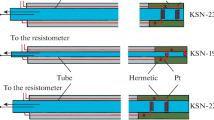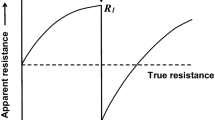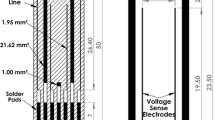This study discusses the problem of increasing the accuracy of contact conductometers. This study also describes the main sources of error in the primary measuring transducer of a contact conductometer, which include the solution resistance, polarization resistance, and capacitance of the double electric layer and the characterization of the electrochemical processes on the primary measuring transducer electrodes. Moreover, this study presents the methods for determining the specific parameters that affect the impedance of the primary measuring transducer. Method 1 is based on the analysis of the amplitude–frequency characteristics of the active component of the impedance of the conductive cell of a contact conductometer filled with a solution. Method 2 is based on the determination of the active component of the impedance of the solution at the resonance frequency, i.e., at zero reactive components of the impedance. In Method 3, the active component of the impedance of the solution is determined at three different frequencies. Results showed that Method 2 can only reliably determine the active resistance of the solution. The cell constants are determined by Methods 1 and 3 in the same frequency range. Meanwhile, Method 2 uses a frequency that is several times higher than the upper limit of the frequency range. Notably, the cell constants determined by Methods 2 and 3 practically coincide with each other and significantly differ from the cell constants determined by Method 1.



Similar content being viewed by others
References
B. S. Pervukhin, “Methodological error of contact conductometers,” Yestestv. Tekhn. Nauki, No. 1, 176–182 (2011).
M. S. Grilikhes and B. K. Filanovskiy, Contact Conductometry. Theory and Practice of the Method, Khimiya, Leningrad (1980).
K. P. Latyshenko, “Analysis of the basic circuits of contact conductometers,” Vestn. Tambov. Gos. Tekhn. Univ. Anal. Khim, 12, No. 3, 647–653 (2006).
V. A. Solovyov, D. E. Krivobokov, “Analysis of methods for constructing functional transformations in conductometric concentrators,” Izmer. Tekhn., No. 10, 62–66 (2017).
Z. B. Stoynov, B. M. Grafov, et al., Electrochemical Impedance, Nauka, Moscow (1991).
I. A. Dubrovsky, “Cardiac electrode impedance model,” Med. Tekhn., No. 4, 21–25 (2010).
A. G. Kagirov and S. V. Romanenko, “Measurement of the active component of the electrochemical impedance of solutions using a miniature two-electrode conductometric cell,” Vestn. Nauki Sibiri, No. 3 (4), 68–73 (2012).
B. S. Pervukhin, “Determination of the parameters of contact primary transducers of conductometers,” Izmer. Tekhn., No. 3, 61–63 (2008).
B. S. Pervukhin, D. E. Krivobokov, and N. V. Suvorova, “Determination of the parameters of contact conductometric cells,” Polzunov. Alman., No. 1, 63–65 (2014).
A. B. Kilimnik and E. S. Slobina, “Resonance frequencies of oscillations of hydrated ions of sodium, potassium, and chlorine in mixtures of solutions of potassium and sodium chlorides,” Vestn. Tambov. Gos. Tekhn. Univ. Ser: Fiz. Khim., 21, No. 4, 624–629 (2015).
A. B. Kilimnik, “Oscillatory processes in a double electric layer when applying alternating current,” Vestn. Tambov. Gos. Tekhn. Univ. Ser.: Yestestv. Tekhn. Nauki, 11, No. 4, 586–587 (2006).
A. B. Kilimnik and E. S. Slobina, “Influence of concentration and temperature on resonant vibration frequencies of hydrated Cu2+ and 2–SO4 ions and reactive impedance components,” Vestn. Tambov. Gos. Tekhn. Univ. Ser: Fiz. Khim., 18, No. 2, 379–385 (2012).
A. B. Kilimnik and V. V. Yarmolenko, “Conductometric cell for determining the reactive components of the impedance,” Vestn. Tambov. Gos. Tekhn. Univ. Ser: Fiz. Khim., 13, No. 1, 51–56 (2007).
C. Thirstrup, A. Snedden, and L. Deleebeeck, Meas. Sci. Technol., 28, No 12 (2017). https://doi.org/10.1088/1361-6501/aa875d.
N. Jaffrezic-Renault and S. V. Dzyadevych, Sensors, 8, No. 4, 2569–2588 (2008). https://doi.org/10.3390/s8042569.
Author information
Authors and Affiliations
Corresponding author
Additional information
Translated from Izmeritel’naya Tekhnika, No. 1, pp. 46–51, January, 2022.
Rights and permissions
About this article
Cite this article
Pervukhin, B.S., Krivobokov, D.E. & Solov’ev, V.A. Comparative Analysis of Methods for Determining the Primary Measuring Transducer Parameters of a Contact Conductometer. Meas Tech 65, 52–58 (2022). https://doi.org/10.1007/s11018-022-02047-y
Received:
Accepted:
Published:
Issue Date:
DOI: https://doi.org/10.1007/s11018-022-02047-y




